| vantage points for photographers | Photo collection | Photo tip |
Vantage points for photographers |
The following table is to give particularly localunaquainted a few tips concerning places to record video or take photo. For finding the locations a trail map is quite helpful.
From the points of view photos are possible, which contain except the locomotive something train and something landscape also.
| Gernrode | Railroad overpass Osterteichstraße (to late morning) |
|
||
| for climbing friends of rock of the mountain "Alte Burg" above the parking of the open-air swimming pool Osterteich (to late morning) | ||||
| Ostergrund (Easter-ground) |
Heiligenteich (Holy pond) (to noon of the valley way; in the afternoon of the slope) |
|
||
| Sternhaus Haferfeld | Meadows between the flagstops Sternhaus Haferfeld and Sternhaus Ramberg (up to the afternoon) | |||
| Heinrichsburg | Meadow above the castle "Heinrichsburg" (about 1200 m footpath along the track of the railroad overpass above station Mägdesprung) |
|
||
| Meadows directly below the ruin of castle Heinrichsburg | ||||
| Stahlhammer | Rock break-through, railway track at the slope above the road | |||
| Drahtzug | line at the slope briefly before the flagstop | |||
|
Selkewasserfall (Selke-waterfall) |
Rock break-through above the Selke-waterfalls
(acces over the way which starts at Drahtzug) |
|
||
| some hundred meters along the track there is the next rock break-through | ||||
| Alexisbad Klostermühle | Crosswalk at the way to Bremer Teich (Bremen pond) (starting from noon)
Acces of the local input from direction Mägdesprung on the right |
|||
| B 242 direction Harzgerode | Rock beside the road between both railroad overpasses (to noon) |
|
||
| above the first railroad overpass from direction Harzgerode | ||||
| Harzgerode | track through the town before the two railroad overpasses underneath the station | |||
| Silberhütte | Railroad overpass at the sawmill Rinkemühle |
|
||
| about 300 m toward Alexisbad is a further rock break-through, which is artificially secured against rockslide | ||||
| Straßberg | Meadow between Silberhütte and Straßberg from road | |||
| Meadow at the edge of Straßberg of the drive at the north slope | ||||
| Traversing the Selke-valley at km 22,9 - former start of connection track to mine Herzogschacht (to noon) | ||||
| Güntersberge | Mühlteich (Mill pond) in Güntersberge |
|
||
| Brook bridge on the west bank of the Mühlteich (Mill pond) on the way to ruin of Güntersburg (starting from noon) | ||||
| Albrechtshaus | vertex of the railway route; near to the former village Selkenfelde (in the afternoon) | |||
| Stiege / Hasselfelde | Track leads across the high area around Stiege and Hasselfelde. From many places it is observably and therefore ideally particularly for recording video. | |||
| Birkenmoor | pward gradient from direction Eisfelder Talmühle before the flagstop Birkenmoor; trains to Stiege (to noon) |
|
||
| Eisfelder Talmühle | Bridge in the Beretal behind the quarry Unterberg (noon until afternoon) |
If you liked to see a picture larger with better resolution, click the picture or the reference on.
Photos from the 1980's
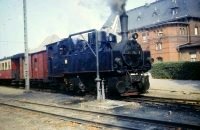
|
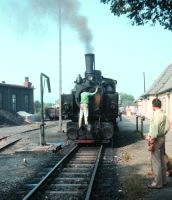
|
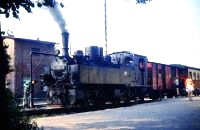
|
| Mallet-locomotive 99 5902 stands before a passenger train in summer of 1981 in Gernrode photo: Klaus Gottschling Zoom 58,0 KB |
Before departure of the train ash is pulled from the smoke chamber of loco 99 5902 photo: Klaus Gottschling Zoom 49,2 KB |
Loco 99 5902 with passenger train in Gernrode - summer 1981 photo: Klaus Gottschling Zoom 52,0 KB |
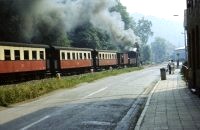
|
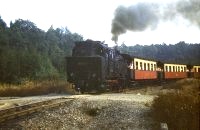
|
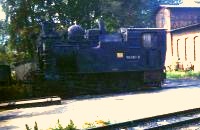
|
| Train with loco 99 5902, open car, baggage car and passenger cars in the status before the reconstruction is passing through Alexisbad in summer 1981 photo: Klaus Gottschling Zoom 58,0 KB |
train with loco 99 6001-4 before the station Sternhaus Ramberg in summer 1981 photo: Klaus Gottschling Zoom 125,0 KB |
In 1981 loco 99 6102 (Fiffi) was stored at the locomotive shed in Gernrode photo: Klaus Gottschling Zoom 51,0 KB |
more photos
Photo tips |
(out: Meyers travel books 'The Harz', large output, twentieth edition, Leipzig and Vienna. Bibliographic institute 1909.)
| links |